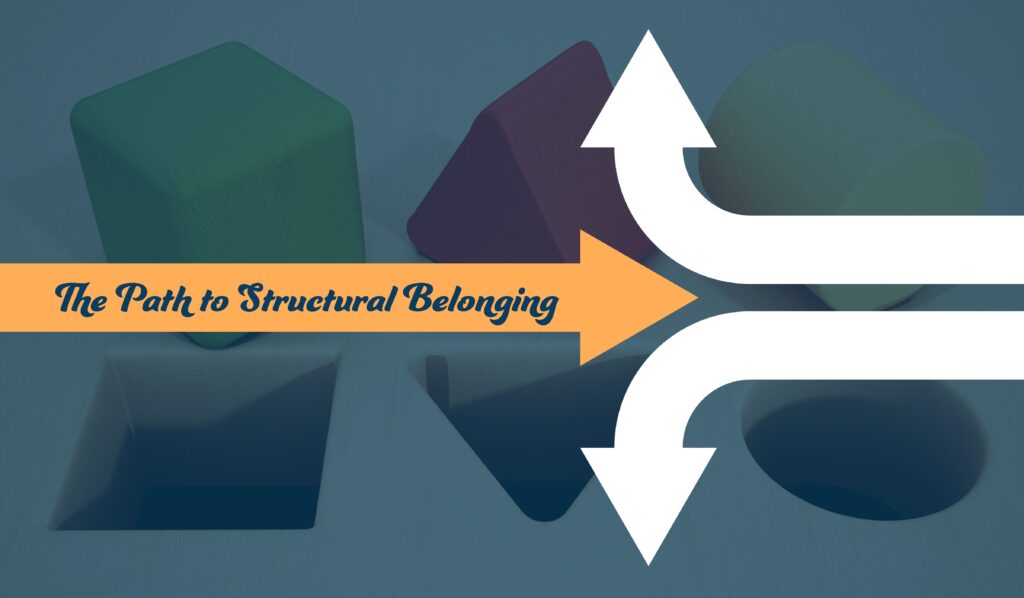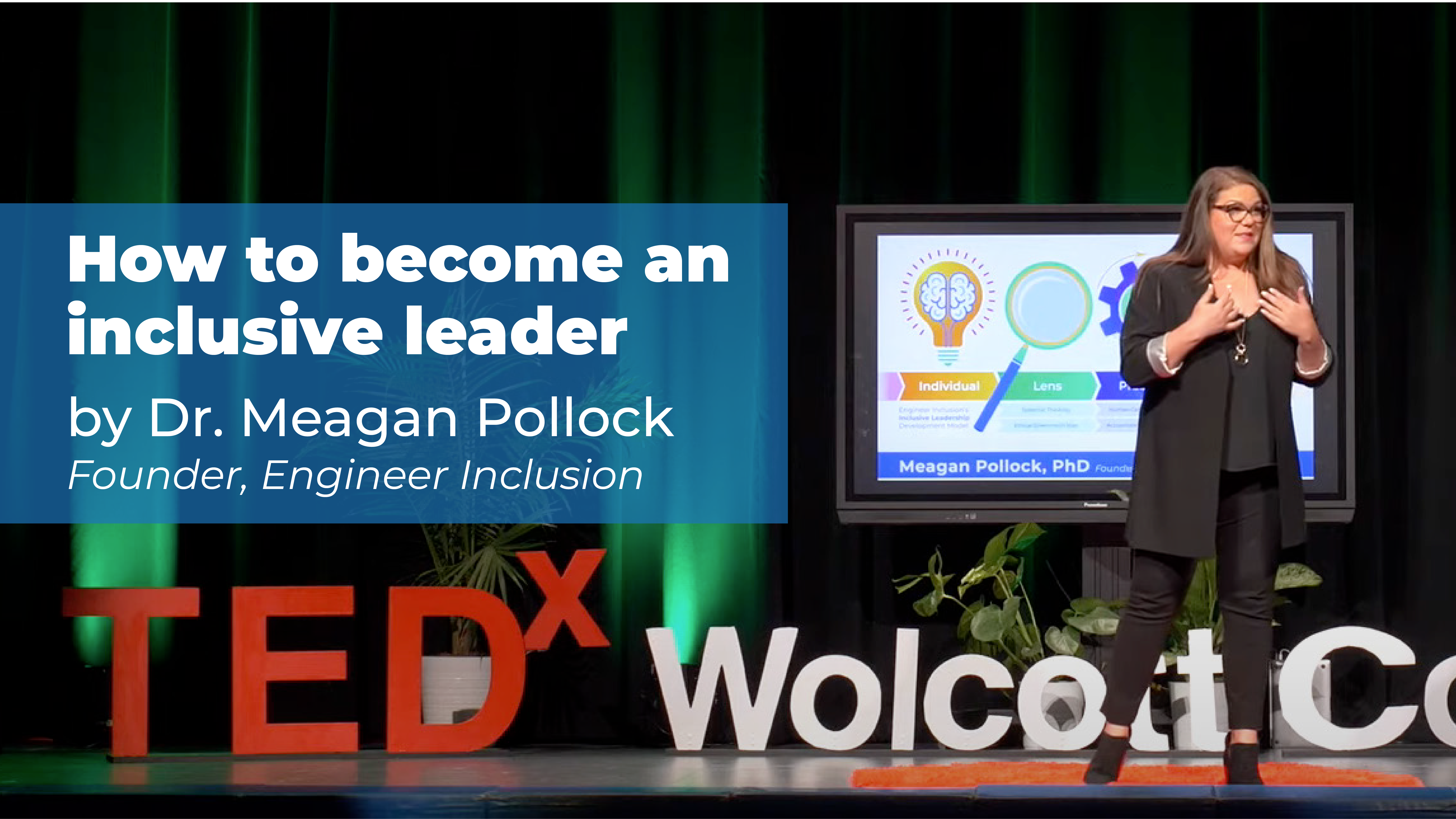Understanding the difference between forced and structural belonging is key to creating genuinely inclusive environments. This post explores these concepts and emphasizes the importance of fostering structural belonging for true inclusivity and equity.
Belonging is a fundamental human need and critical for creating workplaces and learning environments where everyone has the potential to succeed. However, creating inclusive environments requires understanding different types of belonging. Forced belonging involves superficial inclusion, while structural belonging leads to deep, systemic integration. This blog post explains these concepts and highlights the importance of fostering structural belonging for true inclusivity and equity.
Watch this ~3 minute introduction to forced vs structural belonging.
Forced Belonging
Navigating Underlying Pressures
Forced belonging occurs when individuals feel the need to conform to the prevailing norms and culture of a group, often at the expense of their authentic selves. In STEM fields, where women and other underrepresented groups can find themselves in the minority, the pressure to assimilate can be particularly pronounced. Many times, we don’t even realize we are doing it, as our desire to belong is such a human condition. The act of adapting, assimilating, and adjusting can also be a survival tactic, or a form of code switching, within cultures and climates that are foreign to our own.
Examples of Forced Belonging
Student Example: Maya’s Journey in STEM
Maya, an undergraduate student majoring in Mechanical Engineering, is one of the few women in her program. Her journey highlights the challenges faced by women in STEM and the pressures to conform to the dominant culture.
- Adapting: Maya adopts the assertive communication style of her male peers to have her ideas accepted, even though it feels unnatural.
- Assimilating: She participates in informal study groups and social gatherings that she doesn’t enjoy but views as necessary for academic success.
- Adjusting: Maya shifts her academic interests to align with popular topics among her peers and professors, sidelining her genuine passions.
While Maya manages to achieve a semblance of belonging, it is conditional and requires her to sacrifice her authentic self. This forced belonging leads to emotional and cognitive burdens, potentially resulting in feelings of isolation and imposter syndrome.
This is an illustrative example of a woman in STEM adapting, assimilating, and adjusting to the work environment in an effort for forced belonging. It could be the story of “Maya” (a fictional composite based on common experiences).
Maya is an undergraduate student majoring in Mechanical Engineering, one of the few women in her program. Her journey reflects both the challenges and resilience of women in STEM fields, serving as a poignant example for educators and administrators to understand and address these dynamics in their environments.
Background:
Maya always had a passion for engineering, inspired by the potential to innovate solutions for real-world problems. However, upon entering her university program, she quickly noticed the stark gender disparity and the different ways in which her male peers and professors treated her. She felt an underlying pressure to prove her worth and legitimacy in a field predominantly occupied by men.
Adapting:
To fit in, Maya started to engage in behaviors and adopt mannerisms she observed from her male counterparts. She noticed that her ideas were more readily accepted when she spoke with a certain assertiveness, mirroring the communication style of her male peers. Maya also adjusted her appearance to blend in, opting for attire that was more neutral and less expressive of her personal style.
Assimilating:
Recognizing that informal study groups and social gatherings were key to forming study partnerships and accessing collaborative opportunities, Maya made efforts to assimilate into these predominantly male groups. This often meant participating in conversations and activities that didn’t interest her or fully align with her values, but she saw it as necessary for her academic and professional advancement.
Adjusting:
Maya also adjusted her academic interests to align more closely with projects and topics that were popular among her peers and professors, even if they were not her first choice. She found herself taking on roles in group projects that were less about design and innovation, and more about coordination and administration, roles that were subtly steered towards her.
The Impact:
While Maya achieved a sense of belonging and acceptance through these adaptations, it came at a cost to her authentic self-expression and interests. She often felt the emotional and cognitive burden of continuously navigating these dynamics, which could lead to feelings of isolation and imposter syndrome.
Reflection for Educators and Administrators:
Maya’s story highlights the need for systemic changes in STEM education environments to foster genuine inclusivity and belonging for women. Educators and administrators should:
- Create spaces that value diverse perspectives and ways of knowing, acknowledging the richness that women and underrepresented groups bring to STEM.
- Implement policies and practices that actively counteract gender biases and stereotypes, ensuring that all students have equal access to opportunities and resources.
- Foster a culture of mentorship and support, connecting students with role models and mentors who can guide and affirm them in their journey.
Through understanding stories like Maya’s, educators and administrators can better appreciate the nuanced realities of women in STEM and take proactive steps towards creating a more equitable and inclusive educational environment.
Industry Example: Dr. Ana Rivera in Tech
Dr. Ana Rivera, a computer scientist at a leading tech company, also experiences forced belonging.
- Adapting: Dr. Rivera mirrors the direct and assertive communication style of her male colleagues.
- Assimilating: She joins after-work gatherings and hackathons, despite feeling out of place, to integrate into key decision-making groups.
- Adjusting: She focuses on high-status projects to gain visibility, even if they are not her primary interest.
Dr. Rivera’s belonging remains conditional, tied to her ability to conform to the dominant norms. This forced belonging impacts her well-being and sense of identity, preventing her from fully expressing her authentic self.
This illustrative example, while generalized, can help highlight the experiences of many women in STEM fields. This example involves a composite character, “Dr. Ana Rivera,” a woman in the field of computer science. Dr. Rivera’s journey reflects the challenges and adaptations many women face in STEM.
Background:
Dr. Rivera, a talented and ambitious computer scientist, joined a leading tech company renowned for its innovative products but also known for its male-dominated work culture. Eager to contribute and excel, she found herself in an environment where she was often the only woman in team meetings and project discussions.
Adapting:
To fit in and have her ideas heard, Dr. Rivera found herself adopting communication styles more prevalent among her male colleagues. She noticed that direct and assertive speech tended to be taken more seriously, so she adjusted her natural communication style to mirror this, even though it felt foreign to her.
Assimilating:
Aware of the informal gatherings and discussions that played a significant role in decision-making processes, Dr. Rivera made efforts to be part of these spaces. Despite feeling out of place, she participated in after-work gatherings and weekend hackathons, trying to blend into the dominant culture of her workplace. This assimilation was a strategic effort to become more integrated into the core groups within her department.
Adjusting:
Dr. Rivera also found herself adjusting her interests and project preferences to align with what was considered high-status or high-impact work within her organization, even if these were not her primary areas of interest or expertise. This adjustment was a bid to gain visibility and recognition in an environment that often overlooked the contributions of women.
Forced Belonging:
Despite these efforts, Dr. Rivera’s sense of belonging remained conditional, tied to her ability to conform to the prevailing norms and expectations of her work environment. This forced belonging took a toll on her well-being and sense of identity, as the continuous effort to adapt, assimilate, and adjust kept her from fully expressing her authentic self.
Dr. Rivera’s story highlights the challenges women in STEM face in striving for belonging and recognition. It underscores the need for systemic changes in STEM cultures to foster environments where diversity is celebrated, and everyone can thrive without the need to conform to a singular way of being or working.
Learning Theories and Practice:
From an educational and organizational development perspective, incorporating theories such as Belongingness Theory (Baumeister & Leary, 1995) into STEM environments can provide insights into creating more inclusive and welcoming spaces. Workshops designed to increase awareness among all employees about the diversity of communication styles, work preferences, and the value of inclusive teamwork can help. Applying Bloom’s Taxonomy, these workshops can move from knowledge and comprehension of diversity and inclusion principles to application and analysis of behaviors that promote or hinder a sense of belonging, aiming to create environments where everyone, including women in STEM, can feel valued and integral to the community without the need to force assimilation.
Structural Belonging
Creating Spaces for Authenticity
In contrast, structural belonging is achieved when the environment itself changes to accommodate the diverse needs and identities of all its members, allowing individuals to show up as their authentic selves. This approach requires systemic changes in policies, practices, and cultures to ensure that everyone, regardless of gender, race, or background, feels valued and supported.
Examples of Structural Belonging
Student Example: Zara’s Empowering Environment
Zara, a computer science major at a university committed to diversity, equity, and inclusion, experiences structural belonging. The curriculum highlights diverse contributions and includes case studies from underrepresented groups, allowing Zara to see herself reflected in her studies. She pursues projects that align with her personal interests and cultural background, feeling empowered to bring her whole self to her work. Peer mentorship programs, affinity groups, and workshops support Zara and her peers, reinforcing their sense of belonging. In this environment, Zara thrives, knowing that her unique strengths are valued as assets rather than deficits.
In contrast to environments that require individuals to adapt for forced belonging, a structural belonging framework prioritizes adjustments in the environment itself to embrace and celebrate diversity, allowing everyone, including women in STEM, to thrive as their authentic selves.
An illustrative example of this can be seen in the story of “Zara,” a computer science major at a university that has actively cultivated an asset or strengths-driven culture. This example serves as an inspirational model for educators and administrators aiming to foster inclusivity and empowerment in their STEM programs.
Background:
Zara is passionate about artificial intelligence and its potential to solve societal challenges. Unlike many traditional STEM environments that often indirectly promote conformity, her university’s computer science department has undertaken significant efforts to ensure that the environment supports and encourages diversity, equity, and inclusion.
Cultivating an Asset-Based Culture:
The department initiated a comprehensive review of its curriculum, pedagogy, and support systems to identify and dismantle barriers to inclusion. Recognizing the unique perspectives and skills each student brings, the curriculum was redesigned to highlight the importance of diverse thought in innovation. Courses now include case studies of contributions from women and underrepresented minorities in tech, showcasing a broad spectrum of success and innovation.
Fostering Authenticity:
Zara and her peers are encouraged to pursue projects that align with their interests and cultural backgrounds, highlighting the value of diverse viewpoints in creating impactful technology. Faculty members receive training in inclusive teaching practices, ensuring they can support and mentor students in a way that values each individual’s strengths and background.
Supporting Structures:
The department established peer mentorship programs, pairing incoming students with upperclassmen, and created affinity groups for women and minorities in STEM, providing spaces for students to share experiences and support one another. Workshops on topics like overcoming imposter syndrome and leadership development are regularly offered, reinforcing the message that all students belong and have valuable contributions to make.
Impact:
In this environment, Zara feels empowered to bring her whole self to her studies and extracurricular activities. She leads a project team developing AI solutions for language preservation in minority communities, a project that aligns with her personal passions and utilizes her unique strengths. Her experience is a testament to the positive outcomes when institutions prioritize structural belonging, making systemic changes to ensure everyone can succeed without sacrificing their identity.
Reflection for Educators and Administrators:
Zara’s story exemplifies how creating structures of belonging in STEM education can lead to more vibrant, innovative, and inclusive learning environments. To replicate such a culture, educators and administrators should:
- Review and revise curricula to include diverse perspectives and acknowledge various contributions to the field.
- Provide professional development for faculty and staff focused on inclusive practices and recognizing unconscious biases.
- Create support systems and networks that affirm students’ identities and foster a sense of community.
- Encourage student-led initiatives and projects that align with personal interests and cultural backgrounds, celebrating the diversity of thought and experience.
By actively reshaping the environment to promote structural belonging, educational institutions can enable all students, especially women and underrepresented groups in STEM, to flourish while being their authentic selves, driving innovation through diversity.
Industry Example: Leila’s Empowering Workplace
Leila, a software engineer at Tech Innovators Inc., experiences structural belonging in her workplace. The company actively recruits diverse talent and highlights contributions from underrepresented groups, making Leila feel valued from the start. She leads cybersecurity projects that align with her interests, integrating her personal passions with her professional work. Mentorship programs and Employee Resource Groups (ERGs) provide her with a supportive network, allowing her to show up authentically without hiding parts of herself. In this inclusive environment, Leila feels empowered and recognized for her unique strengths, driving innovation within the company.

The Path to Structural Belonging
Achieving structural belonging in STEM fields involves several key strategies:
- Conducting Regular Audits: Organizations should continually assess their policies, practices, and culture to identify barriers to inclusion and areas for improvement.
- Implementing Systemic Changes: Based on audit findings, make targeted changes to policies, practices, and culture to remove barriers and promote inclusivity.
- Promoting Diverse Role Models: Highlighting the achievements of diverse individuals in STEM can inspire and encourage underrepresented groups.
- Fostering Community and Support Networks: Creating mentorship opportunities, affinity groups, and other support networks can help individuals feel a sense of community and belonging.
- Encouraging Authentic Self-Expression: Cultivate an environment where all members are encouraged to be their authentic selves, valuing diversity of thought and experience.
Conclusion
The difference between forced and structural belonging underscores the need for a shift from superficial inclusion efforts to deep, systemic changes that foster genuine inclusivity. By focusing on structural belonging, STEM fields can create environments where everyone, regardless of their background or identity, feels valued, supported, and able to contribute fully. This not only benefits individuals but also enriches the STEM community as a whole, driving innovation and progress through a diversity of perspectives and experiences.
Hire us to lead a workshop for your team!
Creating truly inclusive environments in STEM requires moving beyond superficial inclusion to structural belonging. This workshop will delve into the differences between forced belonging, where individuals feel pressured to conform, and structural belonging, where the environment adapts to support diverse identities. Participants will explore real-world examples, engage in interactive discussions, and learn strategies to implement systemic changes that promote genuine inclusivity. Join us to discover how to cultivate spaces where everyone can thrive authentically and contribute their unique strengths.














